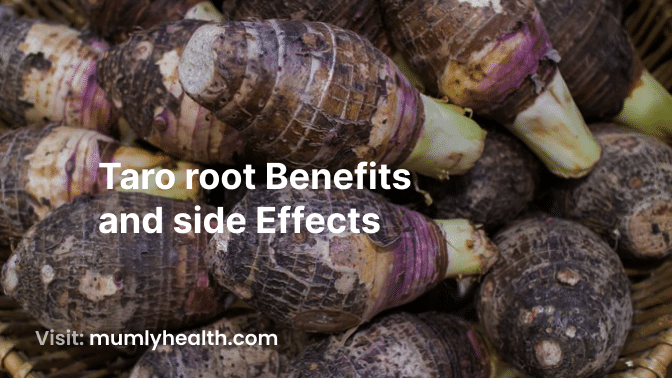Taro root, also known as colocasia esculenta, is a starchy tuber vegetable that has been consumed for centuries in various cuisines worldwide. It is widely recognized for its unique flavour, versatility in cooking, and numerous health benefits.
In this article, we will explore the nutritional profile of taro root and delve into its remarkable benefits and potential side effects.
Nutritional Profile of Taro Root
Taro root is a nutrient-dense vegetable that offers an array of essential vitamins, minerals, and dietary fibre. A 100-gram serving of cooked taro root contains approximately 112 calories, 2 grams of protein, 26 grams of carbohydrates, and 4 grams of fibre. It is also a good source of potassium, magnesium, vitamin C, vitamin E, and various B vitamins.
Health Benefits of Taro Root
- High in Fiber: Taro root is rich in dietary fibre, which promotes healthy digestion, prevents constipation, and supports overall gut health. The fibre content aids in regulating bowel movements and can contribute to a feeling of fullness, making it beneficial for weight management.
- Good Source of Vitamins and Minerals: Taro root is packed with essential vitamins and minerals that play vital roles in maintaining optimal health. It contains potassium, which supports heart health and helps regulate blood pressure. Additionally, it provides magnesium, vitamin C, vitamin E, and various B vitamins that are crucial for energy production, immune function, and cell regeneration.
- Digestive Health: The high fibre content in taro root helps promote a healthy digestive system by improving bowel regularity and preventing digestive disorders like constipation and haemorrhoids. It can also support the growth of beneficial gut bacteria, enhancing overall gut health.
- Weight Management: Due to its high fibre and low-calorie content, taro root can be an excellent addition to a weight management diet. The fibre helps control appetite, reduce overeating, and increase satiety, making you feel fuller for longer periods.
- Cardiovascular Health: Potassium, present in taro root, is known to help maintain healthy blood pressure levels. By reducing sodium retention and relaxing blood vessels, it supports cardiovascular health and reduces the risk of heart disease and stroke.
- Blood Sugar Control: Taro root has a low glycemic index, which means it has a minimal impact on blood sugar levels. This quality makes it a suitable food choice for individuals with diabetes or those aiming to maintain stable blood sugar levels.
- Anti-inflammatory Properties: Taro root contains antioxidants and phytonutrients that exhibit anti-inflammatory properties. These compounds help reduce inflammation in the body, which is associated with chronic diseases such as arthritis, heart disease, and certain types of cancer.
- Immune System Support: The presence of vitamin C in taro root contributes to a robust immune system by stimulating the production of white blood cells and enhancing the body’s ability to fight off infections and illnesses.
- Bone Health: Taro root contains calcium and magnesium, essential minerals for maintaining strong and healthy bones. Regular consumption can help prevent conditions like osteoporosis and improve overall bone density.
Potential Side Effects of Taro Root
- Allergies and Skin Irritation: Some individuals may experience allergic reactions to taro root, primarily when consumed raw. Skin irritation, itching, and swelling can occur in sensitive individuals. It is advisable to cook taro root thoroughly to reduce the risk of allergic reactions.
- Oxalate Content and Kidney Stones: Taro root contains oxalates, which are naturally occurring compounds that can contribute to the formation of kidney stones in susceptible individuals. If you have a history of kidney stones or are prone to oxalate-related issues, it is recommended to moderate your consumption of taro root and consult with a healthcare professional.
Read Also: " Exploring the Pros and Cons of Pills to Flatten Your Stomach"
Tips for Incorporating Taro Root into Your Diet
- Cooking and Processing Precautions: It’s important to note that raw taro root contains calcium oxalate crystals, which can cause mouth and throat irritation. To ensure safety, taro root should be cooked thoroughly by boiling, steaming, or baking before consumption. Peel the skin carefully to avoid skin contact with the sap, which may cause skin irritation in some individuals.
- Cooking Methods and Recipes: Taro root can be prepared in various delicious ways. It can be boiled and mashed, added to stews and soups, or even used in baking. Popular dishes include taro chips, taro fries, taro cake, and taro bubble tea. Experiment with different recipes to find your favourite way of enjoying this versatile root vegetable.
- Safety Precautions: When handling taro root, it is advisable to wear gloves to protect your skin from potential irritation. Properly wash and peel the root before cooking, and ensure it is cooked thoroughly to neutralize any potential toxins.
Conclusion
Taro root is a nutritious and flavoursome vegetable that offers a range of health benefits. From its fibre content aiding digestion to its wealth of vitamins and minerals supporting various bodily functions, taro root can be a valuable addition to a well-rounded diet.
However, it’s important to be aware of the potential side effects, such as allergies and the presence of oxalates, which may affect certain individuals. By cooking taro root properly and consuming it in moderation, you can enjoy its numerous benefits while minimizing any potential risks.
